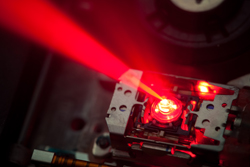Pinning laser lights down to the attosecond
Lasers can produce pulses of light that have a variety of uses in science and technology. The quicker the pulse, the more potential for novel and better applications in research laboratories, with a variety of new ideas that will advance the cause of science. In recent years science created lasers that produce pulses in the femtosecond range (one quadrillionth of a second). The next frontier is to produce pulses in the attosecond range (one quintillionth of a second). Attosecond technology can lead to numerous applications in atomic and molecular physics, as well as in material and surface science. The EU-funded project 'Attosecond Coherent Control' (Attoco) worked on overseeing the generation of attosecond pulses. It started by upgrading current laser facilities at Lund University in Sweden, installing a new state-of-the-art laser system to produce these attosecond pulses. This allowed the team to create stable attosecond pulses, with the number of pulses in trains that are capable of being varied roughly between 1 and 10 isolated pulses. This heralded a new level of laser control that opens up a world of possibilities. The team even recorded strong modulation of the ionisation signal on an attosecond time scale using attosecond pulse trains that were centred below the ionisation threshold of helium atoms. In addition, this precision of pulse trains was exploited in further experiments to control a variety of ionisation, excitation and dissociation processes in atoms, molecules and more complex systems. All this can be realised by directly altering the electronic motion of these minute bodies on the attosecond time scale. In the upgraded laboratory the team worked on vacuum technology, specialised high-level instrumentation, temporal gating, ultrashort pulse measurements using different devices, laser beam pointing and pulse energy stabilisation. These topics will help to advance the applications of attosecond laser pulses with a myriad of surprising results expected in the next few years.







